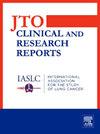脑转移 NSCLC 的 PD-L1、肿瘤突变负担和预后:简要报告
IF 3.5
Q2 ONCOLOGY
引用次数: 0
摘要
非小细胞肺癌合并脑转移的患者预后较差。脑定向放射治疗(RT)联合免疫检查点抑制剂(ICIs)可能具有协同作用。然而,缺乏反应和毒性的预测因子。该研究于2015年至2023年在丹娜-法伯布里格姆癌症中心进行,纳入了非egfr和非alk改变的非小细胞肺癌患者,以及在脑定向rt后90天内开始ICI的新诊断脑转移患者。我们评估了患者水平的全因死亡率、全身和神经系统死亡、全身和颅内进展,以及转移水平的局部复发和放射性坏死。结果178例536例脑转移患者中,中位年龄64岁,女性占53%。诊断时发现的脑转移瘤中位数为3个。大多数患者接受派姆单抗治疗(93%),并接受立体定向放疗(81%)。较高的程序性死亡配体1 (PD-L1)表达与全因死亡率的改善相关(中位生存期:PD-L1小于1%:10.7个月,1% - 49%:14.3个月,大于或等于50%:29.5个月),这是由较长的全身性死亡时间驱动的。较高的PD-L1也与改善的全身无进展生存期(p≥50% vs <1% = 0.02)和远处颅内无疾病生存期(p≥50% vs <1% = 0.02)相关。所有组的局部复发率均较低(2 y时为1% - 4%)。PD-L1较高的患者放射坏死率较高(2 y时PD-L1为2.3%,5.5%,9.3%,1% - 49%,≥50%,p≥50%,p = 0.08),症状性放射坏死率明显较高(p≥50%,p = 0.04)。结论脑导向RT联合ICI治疗非小细胞肺癌合并脑转移是有效的。虽然高PD-L1水平与更长的生存期和更好的颅内控制有关,但在PD-L1高表达的患者中更常发生放射性坏死。临床医生应该意识到这一人群的长期治疗相关的毒性。本文章由计算机程序翻译,如有差异,请以英文原文为准。
PD-L1, Tumor Mutational Burden, and Outcomes in NSCLC With Brain Metastases: A Brief Report
Introduction
Patients with NSCLC and brain metastases have a poor prognosis. Combining brain-directed radiation therapy (RT) with immune checkpoint inhibitors (ICIs) may be synergistic. Nevertheless, predictors of response and toxicity are lacking.
Methods
This retrospective study conducted at Dana-Farber Brigham Cancer Center from 2015 to 2023 included patients with non-EGFR and non-ALK-altered NSCLC and newly diagnosed brain metastases starting ICI within 90 days of brain-directed RT. We assessed all-cause mortality, systemic and neurologic death, systemic and intracranial progression at the patient level, and local recurrence and radiation necrosis at the metastasis level.
Results
Among the 178 patients with 536 brain metastases, the median age was 64 years, and 53% were female individuals. The median number of brain metastases detected at diagnosis was three. Most patients received pembrolizumab (93%) and were treated with stereotactic radiation (81%). Higher programmed death-ligand 1 (PD-L1) expression was associated with improved all-cause mortality (median survival: PD-L1 less than 1%: 10.7 mo, 1%–49%: 14.3 mo, more or equal to 50%: 29.5 mo), driven by longer time to systemic death. Higher PD-L1 was also associated with improved systemic progression-free survival (p≥50% versus <1% = 0.02) and distant intracranial disease-free survival (p≥50% versus <1% = 0.02). The rate of local recurrence was low across all groups (1%–4% at 2 y). Patients with higher PD-L1 had numerically higher radiographic radiation necrosis rates (2.3%, 5.5%, 9.3% at 2 y for PD-L1 <1%, 1%–49%, and ≥50%, respectively, p≥50% versus <1% = 0.08) and significantly higher symptomatic radiation necrosis rates (p≥50% versus <1% = 0.04).
Conclusions
The combination of brain-directed RT and ICI is effective in treating patients with NSCLC and brain metastases. Although high PD-L1 levels are associated with longer survival and improved intracranial control, radiation necrosis occurs more frequently in patients with high PD-L1 expression. Clinicians should be aware of long-term treatment-related toxicities in this population.
求助全文
通过发布文献求助,成功后即可免费获取论文全文。
去求助
来源期刊

JTO Clinical and Research Reports
Medicine-Oncology
CiteScore
4.20
自引率
0.00%
发文量
145
审稿时长
19 weeks
 求助内容:
求助内容: 应助结果提醒方式:
应助结果提醒方式:


